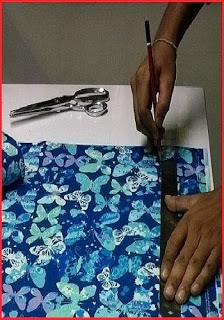Fabric is the main raw material for the apparel industry, and it takes 60-70% of total garment manufacturing cost. Once any fabric consignment received by factory material department, they have to send those to cutting QC within 48 hours to make shade separation, lab test and physical inspection etc. To ensure that only quality fabric is using in garments and factory should take some protective action and grow up fabric inspection department’s strength with qualified personnel. When the quality team receives any fabric consignment for inspection from the store then they will start below three different steps simultaneously to minimize finished garment’s rejection, increase production capability, increase factories goodwill and quality team faith etc.
1. Make shade swatch card to identify if there are any different shade within a consignment.
2. Select some rolls randomly if there is any running shading within the roll.
3. Send every shade to the laboratory to get shade variation report.
Laboratory test of fabric:
For lab test purposes quality team should take 1/2 yard of fabric from each roll and send those to lab room for following tests.
1. Colorfastness for all types of fabric
3. Shade variation analysis (through spectrophotometer)
4. Other tests if required.
Quality team compares that laboratory test report with buyer/customer standard, and if lab report failed to meet that standard, quality team hold that fabric for cutting until getting any response from buyer/customer.
Fabric inspection
According to the 4 point system, factory quality team will check all fabric randomly (as per 2.5 AQL) of that consignment. As per AQL system if random inspection fail then they proceed for 60% inspection but if 60% fails then need to do 100% inspection. If 100% inspection necessary for any consignment then factory quality team will have to charge against the fabric supplier for US $4/hour for their extra task.
Factory quality teams are following the 4-point system based on ASTM D 5430 option A
1. Visually inspects and grade from a viewing distance of one yard while the fabric is in motion. Fabric may be stopped to grade when necessary to affirm marginal defects and defects may be flagged.
2. Inspect and grade the total lengths of each role or bolt sample.
3. Assign points to the defects based on their length of the plane of the fabric according to the following option.
Defect length Assigned points
1″ ~ 3″ 1
3″ ~ 6″ 2
6″ ~ 9″ 3
9″ ~ above 4
4. Assign no more than a total of 4 points to anyone linear yard of fabric, regardless of the number or size of the detected
individual defects.
5. Assign 4 points to each continuous linear yard in which a continuous running defect exceeds 9″.
6. Assign the 4 points to each linear yard of fabric where the available width is less than the minimum specified.
7. Assign 4 points to each seam or other full-width defect or seam if applicable.
Inspection result:
Pass: Maximum 25 points per standard length (where standard length is 100 yards).
Yellow tag: if reject points over 25 and up to 36 points out of 100 yds that will be yellow tag based on defect conditions, location and nature by considering the following things.
1) The special marker can cut the roll.
2) Replacing defective yd. can cut the roll, (by 100% panel inspection)
Red tag: If reject points over 36 out of 100 yards. & worse than yellow tag roll, which we can’t use by above yellow tag’s terms & condition this is considered as red tag.
Inspection at cutting section
To reduce the defect fabrics and save the production cost for smooth production quality team are doing an inspection in two steps.
1. Layer inspection: The principal object of this investigation is whether the layers are lying properly and as per request length. Also, during fabrics layering, if there is any significant defect in fabrics QC stops the layer for layering. QC team doesn’t accept any overlapping layer in this stage. For replacing the reject parts, QC used to keep about five yards of fabrics from every roll.
Quality inspector made this report and submitted to cutting QC, concern cutting chief and merchandising team.
2. Cut panel inspection: After placing the serial number in every component of cut panel, inspection process is started at this stage. Though rolls are accepted in initial inspection still there are some defects on the roll. So the quality team does sort out those defective components during cut panel inspection. QC replaces the defect component from the balance fabrics, which QC kept from each roll,
depends on numbering. It is mention-able that QC does record how many layers have completed from each roll to identify the fabric for replacement. The report we are following call “cut panel inspection report.”
Please find some QC format for your necessary doing and refer to my
google drive link. Please hit the link to download your desired file.





Leave a Reply
You must be logged in to post a comment.